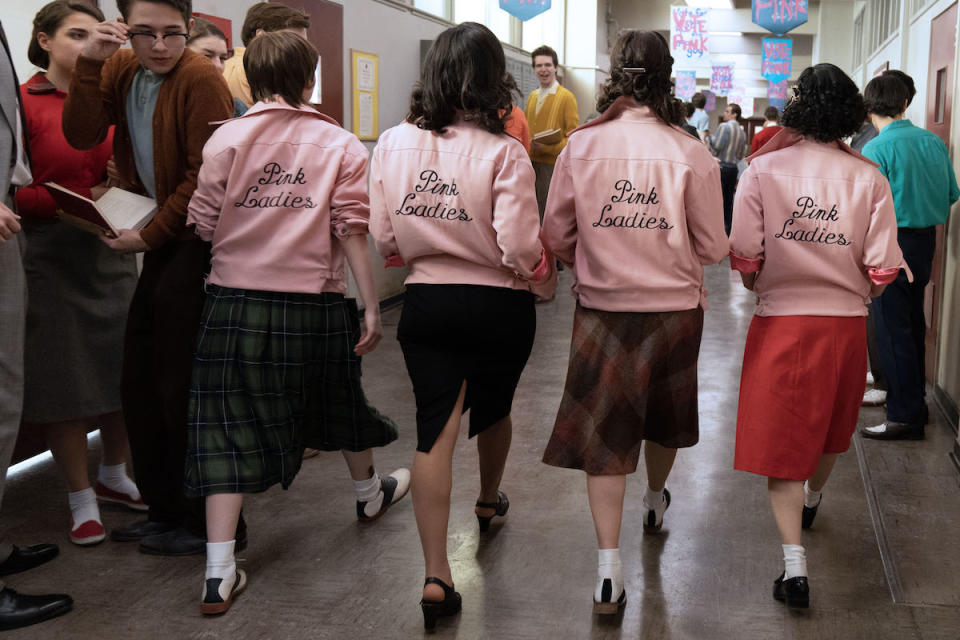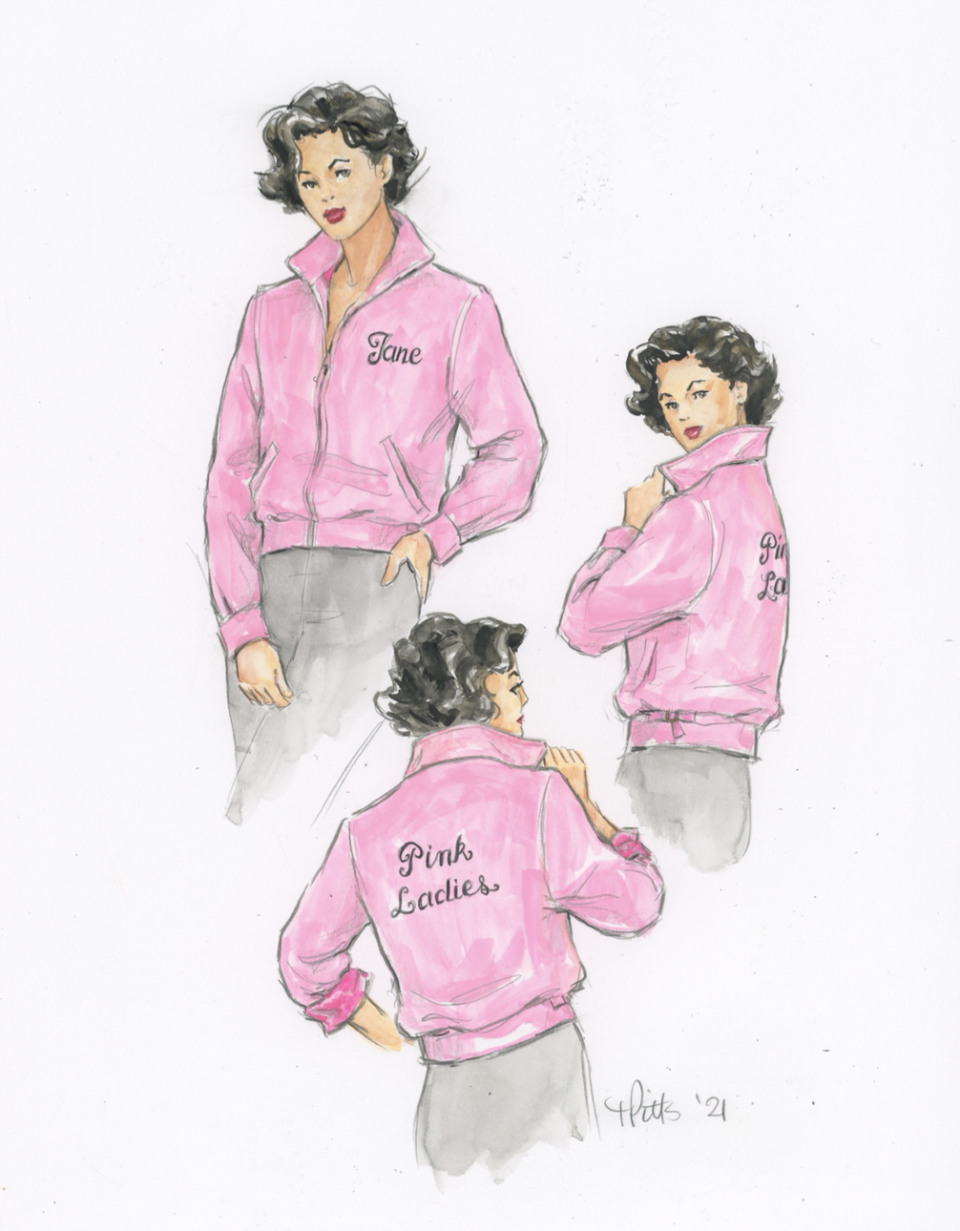'Grease' Turns 45 — Here's a Nostalgic Look at the Iconic Style of the Pink Ladies
- Oops!Something went wrong.Please try again later.
45 years ago this week, a pop culture icon was born. The beloved movie Grease was originally released in theaters on June 16, 1978, and the world of onscreen musicals hasn't been the same since. Grease stars John Travolta and Olivia Newton-John as Danny and Sandy, a pair of 1950s teens who fall for one another despite their different social standings. It remains one of the most popular films of all time, with indelible songs like “Summer Nights,” “Hopelessly Devoted to You” and “You’re the One That I Want” forever burned into the part of our brain that retains song lyrics. (You're singing them now aren't you?)
At the time of release, Grease played into viewers’ sentimentality for previous decades, akin to the 1973 film American Graffiti or the TV show Happy Days. Watching Grease today, there's an extra poignancy due to Newton-John’s sad death in 2022.
Grease: Rise of the Pink Ladies
The movie even spawned a sequel in 1982, and now there's a TV show streaming on Paramount+: Grease: Rise of the Pink Ladies is a prequel that takes place in 1954, four years before the original movie is set. The 2023 musical series serves as an origin story for the Pink Ladies — who, if you recall, are the group of cool greaser girls who invite Sandy into their pink-jacketed clique, led by the strong and sarcastic Betty Rizzo.
The Pink Lady uniform is one of Grease's most memorable fashion statements — and there a lot to choose from, from Danny's slick biker jacket to Sandy's pastel poodle skirts. These jackets make a comeback in the recent series — it's about the Ladies, after all — and in honor of the original movie's anniversary, we asked the new show's costume designer, Angelina Kekich, about the significance of the Pink Ladies and why their style still endures.

Where do the Pink Ladies jackets come from?
In both the original movie and the new show, Pink Lady jackets are pink collared zip-ups with a casual silhouette. The jackets are customized, embroidered with the wearer’s name on the front and “Pink Ladies'' on the back, and all feature a silky lining. The customization was rooted in a real '50s trend: Kekich notes that during this era, a domestic embroidery machine had recently hit the market, which made individualizing one’s clothes a popular hobby.
As it turns out, the Pink Ladies were a real girl gang who existed from 1953 to the early 1960s in Chicago. Like the characters in the movie and show, this tough-girl clique enjoyed going out and dancing. According to one of its real-life members, the Pink Ladies did, in fact, have their own custom outerwear: “We don’t need boys to give us jackets. We’ve got our own," she was quoted as saying in The Chicago Reader. The girl group's name came from a popular cocktail, a mixture of frothy gin and grenadine called — you guessed it — the Pink Lady.

What is Grease Pink Ladies style all about?
Kekich explains that Pink Lady style embodied “a calculated, subtle defiance against strictly enforced dress codes of the 1950s.” Under their signature jackets, the Pink Ladies dress in form-fitting silhouettes, and are more likely to wear pedal pushers or pencil skirts than frilly dresses. In donning their matching jackets, they create a “strong, empowered sisterhood,” as Kekich puts it. While pink is undeniably feminine, the silhouette of these jackets in the movie and show borrows from the boys. Kekich says one of her main inspirations were Harrington jackets, a casual and light style favored by James Dean and other 1950s rebels. She also notes that the advent of rock and roll music would’ve been influential on these characters and how they dressed.
What goes into designing a Grease Pink Ladies jacket?
Before designing her costumes, Kekich had the opportunity to see one of the original 1978 Pink Lady jackets in the flesh — an opportunity she says was invaluable. When it came to actually building the jackets, she stayed close to the instantly recognizable aesthetic of the originals, working hard to ensure the colors and fabrics would be true to the story and comfortable to wear. “We used a Tencel fabric made of natural raw materials, which produced a beautiful soft drape,” she explains. From there, Kekich had to dye the fabric in “the ultimate pink shade,” noting that it was tricky to dye it evenly and manufacture multiple jackets that would appear uniform, while also having enough structure and unrestricted movement to be comfortable for dance sequences.
For the original Grease, the costume designer Albert Wolsky started out by designing outfits that were a bit more understated; but as legend has it, director Randal Kleiser “wanted more color and vibrance,” according to Kekich. From there, “Albert decided to throw the school dress code rules away and went mad, creating an explosion of kaleidoscope colors and flattering, sexy silhouettes” — which included bold pink embellishments. This heightened style worked perfectly for an over-the-top world of a movie musical.
How You Can Incorporate Grease Pink Ladies Style Into Your Life
The Pink Ladies are undeniably stylish — but what if you want to channel their edgy-feminine looks without feeling like you’re wearing a '50s Halloween costume? Kekich says there are several ways to incorporate this playfully rebellious aesthetic into your style at any age. Here’s what she recommends.
For a '50s casual look. If you have any vintage '50s pieces, Kekich suggests mixing them with easygoing staples like jeans. No vintage clothing in your closet? No problem! She says small flourishes like cuffing your jeans or putting on a sassy pair of kitten heels can go a long way.
For a '50s work look. “A tailored, cinched silhouette using your favorite pencil skirt combined with a simple fitted sweater or delicate blouse” is classically '50s without veering into costume territory, says Kekich. For added flair, she suggests belting the waist, or adding a single strand of pearls.
For a '50s party look. “Pair a lightweight skirt or capris with a mainstream cotton sleeveless blouse,” Kekich suggests. If you want to add an extra dash of Pink Lady chic, “pull it all together effortlessly with a fabulous scarf and cat-eye sunglasses. Your most comfortable ballet shoes or espadrilles will complete this dreamy '50s ensemble.”
Ultimately, you don’t need a custom jacket to channel the coolness of a Pink Lady. You can work with what you've got to create a flattering and vibrant retro silhouette.
Grease Pink Ladies Power!
So, 45 years after Grease was released, why does the Pink Lady look endure? “Grease had and still has a huge influence on fashion and pop culture," Kekich concludes. It's all about “independence and the freedom to express oneself with confidence,” says the designer — and this aspirational approach to style can be brought with confidence into any decade.

